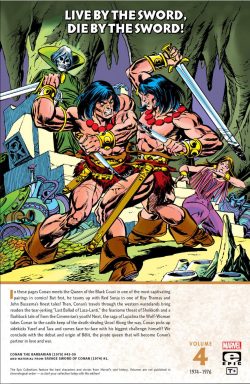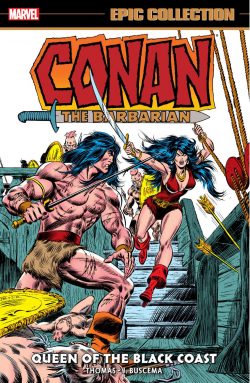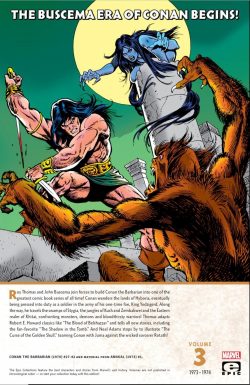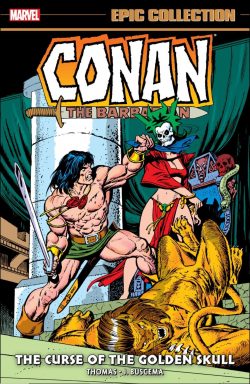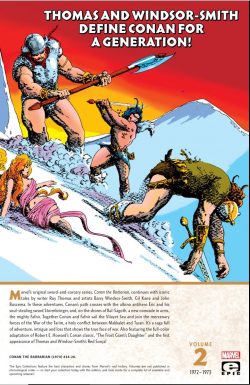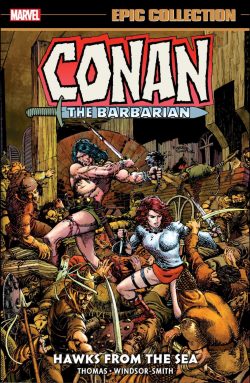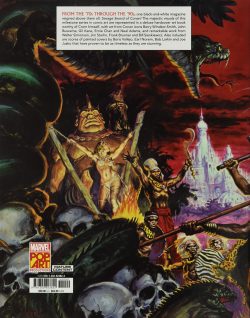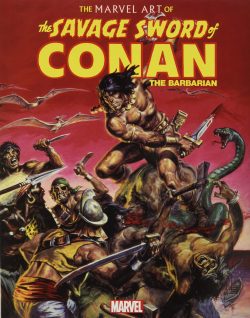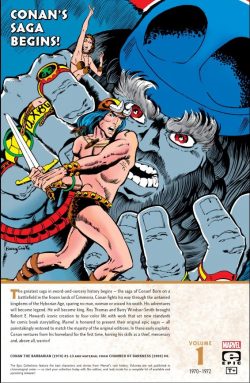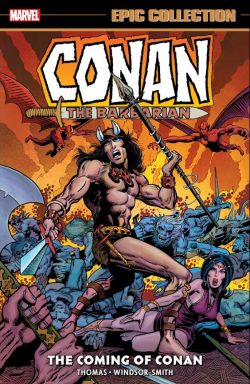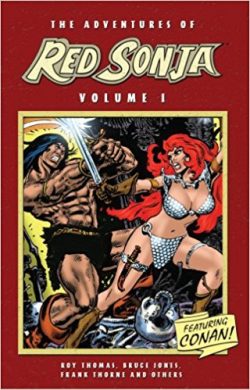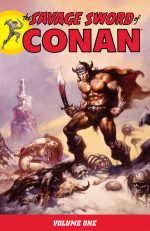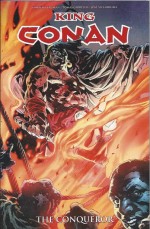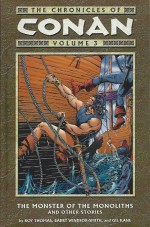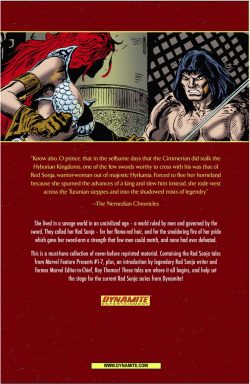
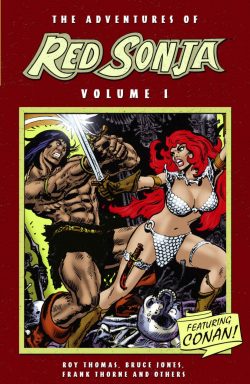
By Roy Thomas, Bruce Jones, Frank Thorne, Dick Giordano, Esteban Maroto, Neal Adams, Ernie Chan & various (Dynamite Entertainment)
ISBN: 978-1-93330-507-3 (TPB/Digital edition)
Once upon a time, busty women expertly wielding swords and kicking butt were rarer than politicians and business leaders who respected personal boundaries. Then – for an inexplicably long time – it seemed no lady’s ensemble was complete without a favourite pig-sticker and accompanying armour accessories. That phenomenon eventually settled into women who fight kitted out and tooled up and those who battled unfeasibly underdressed and usually in gear that looked like it really chafed…
If you’d like more fascinating insights on this state of affairs in entertainment arenas you should also check out Jill Bearup’s Just Stab Me Now and/or her YouTube commentaries and lectures on safely and convincingly fighting with sharp objects, heavy implements and a sanguine attitude…
Meanwhile back in comics, you can probably trace the trend for combative, unsuitably cuirassed or chest plated cuties (just stab ME any time now!) to one breakthrough character. Although Diana Prince/Wonder Woman, Valkyrie, Asgardian goddess Sif and even Modesty Blaise all used bladed weapons on a daily basis, none of them ever racked up the kill quotient you’d expect or believe of women in battle until ‘The Song of Red Sonja’ (Conan the Barbarian #23, February 1973).
Drawn, inked and coloured by Barry Windsor-Smith with Roy Thomas scripting, the fragment of a larger epic introduced a dark-eyed hellion to the world. The tale became one of the most popular and reprinted stories of the decade, winning that year’s Academy of Comic Book Arts Awards in the Best Individual Story (Dramatic) category.
Although based on Robert E. Howard’s Russian war-woman Red Sonya of Rogatine (as seen in the 16th century-set thriller The Shadow of the Vulture, with a smidgen of Dark Agnes de Chastillon thrown into the mix) the comic book Red Sonja is very much Thomas’ brainchild.
In his Introduction here – ‘A Fond Look Back at Big Red’ – he shares many secrets of her convoluted genesis, development and achievements as part of the first (of three) archival collection (available in trade paperback and digital editions) of her Marvel appearances. Originally released at a time when accepted editorial wisdom declared comics starring women didn’t sell, Marvel Feature (volume 2) was launched to capitalise on a groundswell of popular interest stemming from Sonja’s ongoing guest shots in Conan stories. This first compilation collects issues #1-7 (November 1975-November 1976) and opens with a then scarce-seen reprint…
Sonja graduated from cameo queen to her first solo role in a short eponymous tale scripted by Thomas and illustrated by Esteban Maroto, Neal Adams & Ernie Chan, tucked into the premiere issue of monochrome mature-reader magazine Savage Sword of Conan – cover-dated August 1974. Colourised by Jose Villarrubia and edited to remove the racier bits, it filled out the premier general distribution Marvel Feature, and revealed in sumptuous style how the wandering woman mercenary undertook a mission for King Ghannif of Pah-Dishah. That task led to her momentous first meeting with Conan and her successful completion of the mission; which was supposed to pay off with the potentate’s most treasured gift. When that reward turned out to be a position as his next wife, Sonja’s response was swift, sharp and so very memorable…
That captivating catch-up yarn leads here to ‘The Temple of Abomination’ (Thomas & Dick Giordano) as the restless sell-sword stumbles upon a lost church dedicated to debauched antediluvian gods and saves a dying priest of Mitra from further torture at the paws of monstrous beast-men…
MF #2 delivered the last key component of Red Sonja’s ascendancy as Frank Thorne (June 16th 1930-March 7th 2021) signed on as illustrator. One of the most individualistic talents in American comics, he began his career in 1948, drawing romances for Standard Comics with the legendary Alex Toth before graduating to better paid newspaper strips. Thorne illustrated Perry Mason for King Features Syndicate and at Dell/Gold Key drew Flash Gordon, Jungle Jim and The Green Hornet, as well as the first years of seminal sci-fi classic Mighty Samson.
At DC he produced compelling work on Tomahawk and Son of Tomahawk before being hired by Thomas at Marvel to illustrate (belated) breakthrough strip Red Sonja. Forever-after connected with feisty, earthy, highly sexualised women, in 1978 Thorne created outrageously bawdy (some say vulgar) swordswoman Ghita of Alizarr for Warren’s adult science fantasy anthology 1984/1994 and a succession of adult satirical strips like Moonshine McJugs for Playboy and Danger Rangerette for The National Lampoon. He won the National Cartoonists Award for Comic Books, an Inkpot Award, a Playboy Editorial Award and countless international honorariums over his astoundingly long career. Throughout his controversial career, steadfast supportive wife Marilyn worked beside him. Their 69-year marriage ended when they both died on same day – March 7th 2021.
Applying his loose, vigorous style and frenetic design sense to a meticulously plotted script from Bruce Jones, Thorne hit the ground running with ‘Blood of the Hunter’ wherein Sonja tricks formidable rival Rejak the Tracker out of an enigmatic golden key. She has also unsuspectingly unleashed a whirlwind or torment as the hunter remorselessly stalks Sonja, butchering everyone she befriends and driving her to the brink of death before their final confrontation…
Marvel Feature #3 reveals the secret of the key after Sonja takes some very bad advice from an old wise-woman and reawakens a colossal death-engine from an earlier age in ‘Balek Lives!’ before endless meanderings bring her to a village terrorised by a mythological threat. However, when she looks into the ‘Eyes of the Gorgon’ she discovers the most merciless monsters are merely human. That same lesson is repeated when ‘The Bear God Walks’ but – after joining a profitable bounty hunt for a marauding beast – Sonja and her new comrades soon find that fake horrors can inadvertently summon up real ones…
With #6, Thomas returned as scripter and set up a crossover with Conan and then-paramour Bêlit: pirate queen of the Black Coast. Although the concomitant issues of Conan the Barbarian (#66-68) aren’t reproduced here, the story is constructed in such a way that most readers won’t notice anything amiss…
Thus, ‘Beware the Sacred Sons of Set’ sees Sonja – after routing a pack of jackal-headed humanoid assailants – commissioned by Karanthes, High Priest of the Ibis God, to secure a magical page torn from mystic grimoire the Iron-Bound Book of Skelos in demon-haunted Stygia. She’s barely aware of an unending war between ancient deities, or that old colleague and rival Conan of Cimmeria is similarly seeking the arcane artefact…
After clashing repeatedly with her rivals and defeating numerous beasts and terrors, Sonja believes she has gained the upper hand in ‘The Battle of the Barbarians’, but there is more at stake than any doughty warrior can imagine…
To Be Continued…
Augmented by a colour-remastered cover gallery by Gil Kane and Thorne, this is a bold and bombastic furiously fun fiesta for fantasy action fans of all ages, genders or persuasions.
RED SONJA® and related logos, characters, names and distinctive likenesses thereof are trademarks of Red Sonja Corporation unless otherwise noted. All Rights Reserved.

